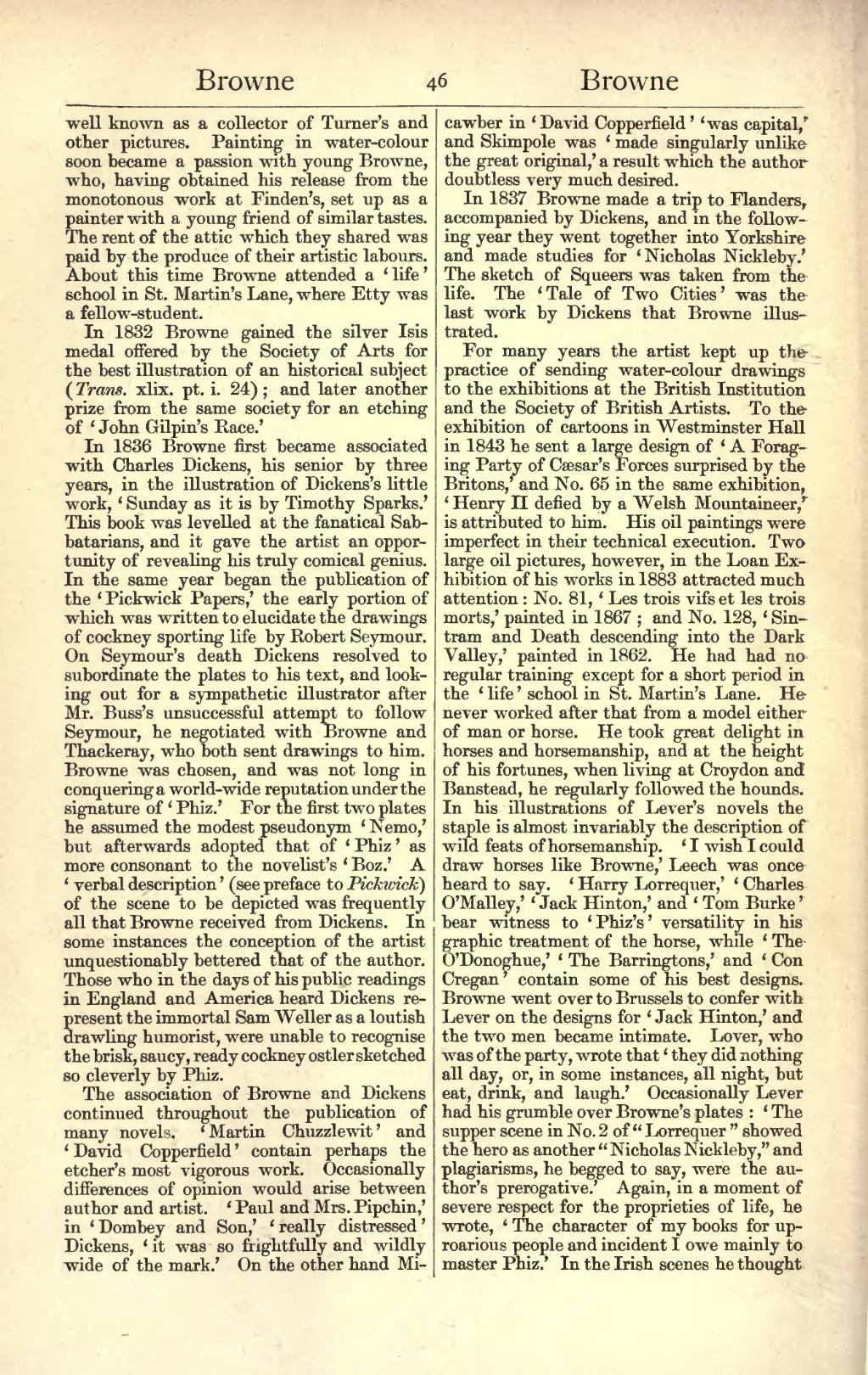well known as a collector of Turner's and other pictures. Painting in water-colour soon became a passion with young Browne, who, having obtained his release from the monotonous work at Finden's, set up as a painter with a young friend of similar tastes. The rent of the attic which they shared was paid by the produce of their artistic labours. About this time Browne attended a 'life' school in St. Martin's Lane, where Etty was a fellow-student.
In 1832 Browne gained the silver Isis medal offered by the Society of Arts for the best illustration of an historical subject (Trans. xlix. pt. i. 24) ; and later another prize from the same society for an etching of 'John Gilpin's Race.'
In 1836 Browne first became associated with Charles Dickens, his senior by three years, in the illustration of Dickens's little work, 'Sunday as it is by Timothy Sparks.' This book was levelled at the fanatical Sabbatarians, and it gave the artist an opportunity of revealing his truly comical genius. In the same year began the publication of the 'Pickwick Papers,' the early portion of which was written to elucidate the drawings of cockney sporting life by Robert Seymour. On Seymour's death Dickens resolved to subordinate the plates to his text, and looking out for a sympathetic illustrator after Mr. Buss's unsuccessful attempt, to follow Seymour, he negotiated with Browne and Thackeray, who both sent drawings to him. Browne was chosen, and was not long in conquering a world-wide reputation under the signature of 'Phiz.' For the first two plates he assumed the modest pseudonym 'Nemo,' but afterwards adopted that of 'Phiz' as more consonant to the novelist's 'Boz.' A 'verbal description' (see preface to Pickwick) of the scene to be depicted was frequently all that Browne received from Dickens. In some instances the conception of the artist unquestionably bettered that of the author. Those who in the days of his public readings in England and America heard Dickens represent the immortal Sam Weller as a loutish drawling humorist, were unable to recognise the brisk, saucy, ready cockney ostler sketched so cleverly by Phiz.
The association of Browne and Dickens continued throughout the publication of many novels. 'Martin Chuzzlewit' and 'David Copperfield' contain perhaps the etcher's most vigorous work. Occasionally differences of opinion would arise between 'author and artist. 'Paul and Mrs. Pipchin,' in 'Dombey and Son,' 'really distressed' Dickens, 'it was so frightfully and wildly wide of the mark.' On the other hand Micawber in 'David Copperfield' 'was capital,' and Skimpole was 'made singularly unlike the great original,' a result which the author doubtless very much desired.
In 1837 Browne made a trip to Flanders, accompanied by Dickens, and in the following year they went together into Yorkshire and made studies for 'Nicholas Nickleby.' The sketch of Squeers was taken from the life. The 'Tale of Two Cities' was the last work by Dickens that Browne illustrated.
For many years the artist kept up the practice of sending water-colour drawings to the exhibitions at the British Institution and the Society of British Artists. To the exhibition of cartoons in Westminster Hall in 1843 he sent a large design of 'A Foraging Party of Caesar's Forces surprised by the Britons,' and No. 65 in the same exhibition, 'Henry II defied by a Welsh Mountaineer,' is attributed to him. His oil paintings were imperfect in their technical execution. Two large oil pictures, however, in the Loan Exhibition of his works in 1883 attracted much attention: No. 81, 'Les trois vifs et les trois morts,' painted in 1867; and No. 128, 'Sintram and Death descending into the Dark Valley,' painted in 1862. He had had no regular training except for a short period in the 'life ' school in St. Martin's Lane. He never worked after that from a model either of man or horse. He took great delight in horses and horsemanship, and at the height of his fortunes, when living at Croydon and Banstead, he regularly followed the hounds. In his illustrations of Lever's novels the staple is almost invariably the description of wild feats of horsemanship. 'I wish I could draw horses like Browne,' Leech was once heard to say. 'Harry Lorrequer,' 'Charles O'Malley,' 'Jack Hinton,' and 'Tom Burke' bear witness to 'Phiz's' versatility in his graphic treatment of the horse, while 'The O'Donoghue,' 'The Barringtons,' and 'Con Cregan' contain some of his best designs. Browne went over to Brussels to confer with Lever on the designs for 'Jack Hinton,' and the two men became intimate. Lover, who was of the party, wrote that 'they did nothing all day, or, in some instances, all night, but eat, drink, and laugh.' Occasionally Lever had his grumble over Browne's plates : 'The supper scene in No. 2 of "Lorrequer" showed the hero as another "Nicholas Nickleby," and plagiarisms, he begged to say, were the author's prerogative.' Again, in a moment of severe respect for the proprieties of life, he wrote, 'The character of my books for uproarious people and incident I owe mainly to master Phiz,' In the Irish scenes he thought
